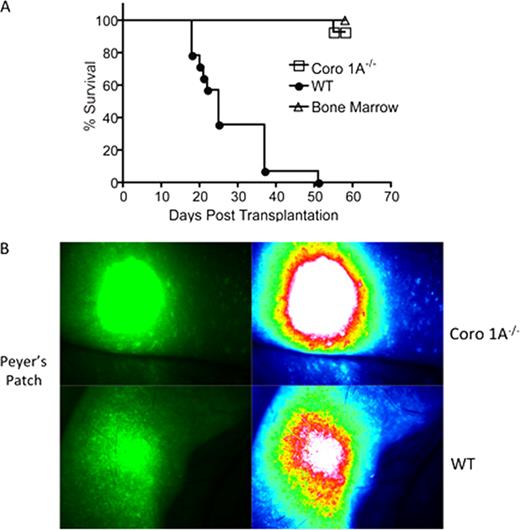Abstract
Abstract 4022
The migration of donor T cells into and out of host lymphoid tissue is critical for the induction of acute Graft-versus-Host Disease (GvHD). A number of groups including ours have found that the lack of lymphoid tissue or impaired migration into that tissue prevented acute GvHD. However, it is not clear if preventing egress of effector T cells from lymphoid tissue can inhibit GvHD. Coronin 1A (Coro 1A) is an actin binding protein involved in cell migration and motility, and has previously been shown to contribute to the ability of T cells to migrate within lymph nodes. To elucidate a role for Coro 1A in GvHD pathogenesis we used mice deficient in Coro 1A (Coro 1A−/−). Methods : A haplotype-matched Hematopoietic Stem Cell Transplant (HSCT) model was used. C57BL/6 (H-2b, “B6”) mice were used as donors while C57BL/6 x DBA2 F1 (H-2bxd, “B6D2”) functioned as recipients. Na•ve conventional T cells (Tns) were isolated from the spleens of wild type B6 (WT), enhanced green fluorescent protein expressing B6 (WT eGFP), Coro 1A−/−B6, and Coro 1A−/−eGFP mice. B6D2 mice were lethally irradiated to 900 rads on day −1 and injected with 4 × 106 Tns from WT, WT eGFP, Coro 1A−/−, or Coro 1A−/−eGFP mice supplemented with 3 × 106 WT B6 T cell depleted bone marrow cells on day 0. Recipients were followed for survival and assessed for GVHD twice weekly using a validated scoring system. In those mice given WT eGFP or Coro 1A−/− eGFP Tns, recipient organs were imaged by stereofluorescence microscopy on days 3 and 14 post transplantation. Results : Mice that received Coro 1A−/− Tns displayed significantly attenuated GvHD with greater than 90% surviving to transplant day 60. In contrast, those animals receiving WT Tns demonstrated a 100% mortality rate by the end of the study period (Fig 1A, p<0.05 by Fisher's exact test). Stereomicroscopy performed 3 days after transplantation demonstrated a lower eGFP signal within the mesenteric lymph nodes (MLNs) and Peyer's patches (PPs) of those mice given Coro 1A−/−eGFP T cells versus those receiving WT eGFP cells. By 14 days post transplantation, however, the converse was observed, with more cells found within the MLNs and PPs of recipient mice receiving Coro 1A−/−eGFP cells (Fig 1B). Total T cells numbers in the liver and colon, however, were decreased at this time point in Coro 1A−/−eGFP recipients, indicating an impaired ability for these cells to exit host lymphatic tissue and traffic to GvHD target organs. Conclusion : These data indicate that impaired egress from lymphoid tissue, by blocking the function of Coro 1A, leads to a profound decrease in GvHD pathology and donor T cells in GvHD target organs. These data suggest that blocking the migration of donor T cells out of lymphoid tissue is a new viable approach to prevent acute GvHD.
Disclosures:
No relevant conflicts of interest to declare.
Author notes
*
Asterisk with author names denotes non-ASH members.
© 2011 by The American Society of Hematology
2011


This feature is available to Subscribers Only
Sign In or Create an Account Close Modal